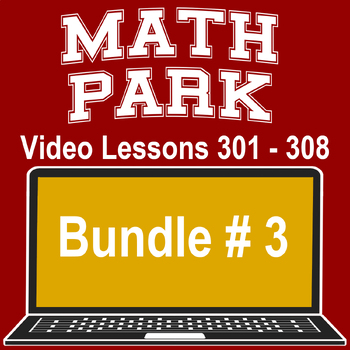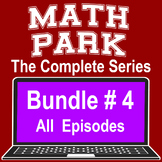COMPLETE FRACTIONS & DECIMALS BUNDLE #3 -MATH PARK VIDEO/EASEL LESSONS 301-308
- Zip
- Easel Activity
- Easel Assessment
Products in this Bundle (8)
showing 1-5 of 8 products
Also included in
- Would you like to find new ways of giving your students a good foundation with number sense, multiplication, and fraction & decimal concepts? Give the Emmy Award-winning MATH PARK a try! These NO-PREP VIDEO LESSONS and follow-up EASEL ACTIVITIES and ASSESSMENTS can give your students the differePrice $45.00Original Price $57.50Save $12.50
Description
Would you like to find new ways of giving your students a good foundation with fraction and decimal concepts? Give the Emmy Award-winning MATH PARK a try! These NO-PREP VIDEO LESSONS and follow-up EASEL ACTIVITIES and ASSESSMENTS can give your students the differentiated help they need.
Here’s what’s included:
- 8 fifteen-minute teaching VIDEO LESSONS
- 8 printable TEACHER GUIDES for making the video lessons more effective
- 8 multiple interactive EASEL ACTIVITIES to reinforce the concepts/skills
- 8 automatically graded EASEL ASSESSMENTS for teacher feedback
The concepts and skills taught in THE MATH PARK COMPLETE FRACTIONS & DECIMALS BUNDLE include:
Lesson 301
- Understanding that fractions are equal parts of a whole
- Learning the names of basic fractional parts (i.e. half (halves), third(s), fourth (s), etc.)
- Learning the meaning of the term, “denominator”
Lesson 302
- Learning the meaning and relationship of the numerator and denominator in fractions
- Identifying fractions after viewing different visual representations, such as bars, squares, rectangles, and circles
- Comparing fractions when the numerators are the same but the denominators are different, such as one-third is larger than one-fourth
Lesson 303
- Comparing fractions with the same numerator and different denominators
- Using fraction bar models makes it easier to compare fractions
- Using fraction bar models for putting fractions in order from least to greatest
- When the numerator and denominator are the same, the fraction is actually one whole.
Lesson 304
- Fractions can also be represented as objects in groups
- Using fractions of a set to introduce the concept of equivalent fractions
Lesson 305
- Colorful visuals demonstrate how two-fourths, three-sixths, five-tenths, etc. are equivalent to one-half.
- Animation of fraction bars and circles helps students to see how different fractions can be equivalent.
- A quick review of comparing fractions that are not equal.
Lesson 306
- The basic concept of adding and subtracting fractions with like denominators
- Why the denominators remain the same when adding or subtracting fractions. Students will understand why the numerators are added or subtracted but the denominator stays the same.
- A quick review of comparing (equivalent) fractions
Lesson 307
- Relating fractions and decimals (tenths)
- How to read decimals aloud correctly
- Understanding the concept of mixed fractions and mixed decimals
- Comparing mixed decimals
- Reviewing equivalent fractions
Lesson 308
- Reviewing how to relate decimals to fractions (tenths)
- Introducing hundredths as decimals and fractions
- Comparing decimals (hundredths)
- Understanding place value with decimals (hundredths)
Here’s what satisfied teachers and parents are saying:
“Math Park is extraordinary! My students love it and actively participate in this interactive math resource. It’s always a treat for them when an episode is shown. Even my most reluctant math learners are engaged. Math Park has a wonderful way of making even the most daunting math concepts accessible to all – in an enjoyable and painless way.”
Natali Escobedo, Teacher
Los Angeles, California
“Math Park is an amazing math tool every teacher should have in the classroom. Math Park helps students improve their math skills interactively with tons of fun. My students enjoyed it and did not stop asking to watch it over and over again.”
Susana Cano, Teacher
Los Angeles, California
“My son has been diagnosed with ADHD and he has a really hard time focusing and staying on task. But the imaginative approach of Math Park really got his attention. Math Park’s positive attitude and energy helped him to keep focused.”
Joanna Rivera, Parent
Los Angeles, California
“The kids LOVE these videos. They are entertaining and yet very informative. You guys have made an incredibly creative and wonderful tool to help students deepen their math concepts. Nice job.”
Ashley Alden, Teacher
Los Angeles, California
I hope you will try MATH PARK in your classroom or at home! I would appreciate your REVIEW/RATING of this MATH PARK lesson.
Please follow me at: https://www.teacherspayteachers.com/Store/Lucky-Cat-Productions
Thanks! Robert



